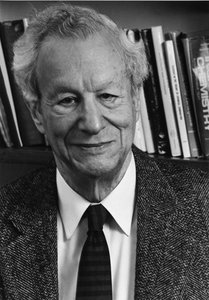
Back فرانك وستهايمر Arabic فرانک وستایمر AZB Frank Westheimer German فرانک وستایمر Persian Frank Westheimer Portuguese Вестхаймер, Фрэнк Russian
Frank Westheimer | |
|---|---|
 | |
| Born | January 15, 1912 Baltimore, Maryland, U.S.[1] |
| Died | April 14, 2007 (aged 95) Cambridge, Massachusetts, U.S. |
| Alma mater | Dartmouth College (BA) Harvard University (MS, PhD) |
| Known for | Mechanisms of enzyme catalysis, and kinetic isotope effects |
| Awards | Centenary Prize (1962) Willard Gibbs Award (1970) NAS Award in Chemical Sciences (1980) Rosenstiel Award (1980) Arthur C. Cope Award (1982) Welch Award in Chemistry (1982) William H. Nichols Medal (1982) National Medal of Science (1986) Priestley Medal (1988) Nakanishi Prize (1997) |
| Scientific career | |
| Fields | Physical organic chemistry |
| Institutions | National Academy of Sciences Harvard University |
| Doctoral advisor | James Bryant Conant, Elmer P. Kohler |
| Doctoral students | Emil T. Kaiser, Roberta F. Colman, Steven A. Benner |
Frank Henry Westheimer (January 15, 1912 – April 14, 2007) was an American chemist. He taught at the University of Chicago from 1936 to 1954, and at Harvard University from 1953 to 1983, becoming the Morris Loeb Professor of Chemistry in 1960, and Professor Emeritus in 1983.[2] The Westheimer medal was established in his honor in 2002.[3]
Westheimer did pioneering work in physical organic chemistry,[4] applying techniques from physical to organic chemistry and integrating the two fields.[5] He explored the mechanisms of chemical and enzymatic reactions,[6] and made fundamental theoretical advances.[5]
Westheimer worked with John Gamble Kirkwood on the Bjerrum electrostatic analysis of carboxylic acids;[4][7][8] with Joseph Edward Mayer on the calculation of molecular mechanics;[4][9] explored the mechanisms of enzyme catalysis with Birgit Vennesland[4][6][10] and determined the mechanisms of chromic acid oxidations and kinetic isotope effects.[11][12]
He received the National Medal of Science in 1986 "For his series of extraordinary, original and penetrating investigations of the mechanisms of organic and enzymic reactions, which have played an unequaled role in the advancement of our knowledge of the ways in which chemical and biochemical processes proceed."[13]
- ^ Cite error: The named reference
Zernerwas invoked but never defined (see the help page). - ^ Cite error: The named reference
OHwas invoked but never defined (see the help page). - ^ Cite error: The named reference
Medalwas invoked but never defined (see the help page). - ^ a b c d Roberts, John D. (1996). "The beginnings of physical organic chemistry in the United States" (PDF). Bulletin for the History of Chemistry. 19. Retrieved 6 March 2018.
- ^ a b Corey, E. J. (April 19, 2007). "Frank H. Westheimer, major figure in 20th century chemistry, dies at 95". Harvard Gazette. Retrieved 6 March 2018.
- ^ a b Simoni, Robert D.; Hill, Robert L.; Vaughan, Martha (January 16, 2004). "The Stereochemistry and Reaction Mechanism of Dehydrogenases and Their Coenzymes, DPN (NAD) and TPN (NADP): the Work of Birgit Vennesland". The Journal of Biological Chemistry. 279 (3): e3. doi:10.1016/S0021-9258(20)73581-7. Retrieved 6 March 2018.
- ^ Kirkwood, J. G.; Westheimer, F. H. (September 1938). "The Electrostatic Influence of Substituents on the Dissociation Constants of Organic Acids. I". The Journal of Chemical Physics. 6 (9): 506–512. Bibcode:1938JChPh...6..506K. doi:10.1063/1.1750302.
- ^ Westheimer, F. H.; Kirkwood, J. G. (September 1938). "The Electrostatic Influence of Substituents on the Dissociation Constants of Organic Acids. II". The Journal of Chemical Physics. 6 (9): 513–517. Bibcode:1938JChPh...6..513W. doi:10.1063/1.1750303.
- ^ Westheimer, F. H.; Mayer, Joseph E. (December 1946). "The Theory of the Racemization of Optically Active Derivatives of Diphenyl". The Journal of Chemical Physics. 14 (12): 733–738. Bibcode:1946JChPh..14..733W. doi:10.1063/1.1724095.
- ^ Westheimer, F. H.; Fisher, Harvey F.; Conn, Eric E.; Vennesland, Birgit (May 1951). "The enzymatic transfer of hydrogen from alcohol to DPN". Journal of the American Chemical Society. 73 (5): 2403. doi:10.1021/ja01149a561.
- ^ Westheimer, F. H. (December 1949). "The Mechanisms of Chromic Acid Oxidations". Chemical Reviews. 45 (3): 419–451. doi:10.1021/cr60142a002.
- ^ Westheimer, F. H. (1 June 1961). "The Magnitude of the Primary Kinetic Isotope Effect for Compounds of Hydrogen and Deuterium". Chemical Reviews. 61 (3): 265–273. doi:10.1021/cr60211a004.
- ^ "The President's National Medal of Science: Recipient Details Frank H. Westheimer". National Science Foundation. Retrieved 9 March 2018.